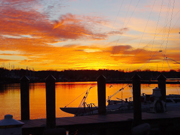How to Choose the Right
 Marina for Your Dream Boat
Marina for Your Dream Boat
by Alice Snively
Along the Bay, from the Patapsco to the Patuxent, you’ve hundreds of marinas and yacht clubs to choose from.
You have finally found your dream boat, (not the person, the vessel). But before you sign on the dotted line, you have to find her a home. Unless you’re lucky enough to have waterfront property and a boat slip of your own, you’ll need to choose a commercial marina or a yacht club. Marinas and yacht clubs on Chesapeake Bay and its tributaries come in all varieties from full service to almost no service, lots of amenities to practically none.
From the Patapsco River east of Key Bridge on the Western Shore to Solomons Island and the Patuxent River, you’ve nearly 100 marinas and yacht clubs to choose from. More than half are located from Annapolis north. With all these possibilities, how do you find the place to park that’s right for your new beauty?
Prepare for a Big Boating Adventure
The search for a marina will be a big boating adventure if you are a first-time boater, and it will be fun. Here’s how I know:
When my husband and I went hunting for a home for our boat, we visited several marinas and clubs, talking to people who had boats at each one as well as the owner or manager. At every stop, we got to hear at least one really good sea story. Salts and sea-goers introduce you to the very special boating culture while keeping your search from becoming drudgery.
Department of Yachtland Security
“Check out the condition of the docks,” advises Marty Schultz of Pasadena. “You can tell a lot about a marina this way.”
The former dock master for Pleasure Cove Marina explains that well-kept docks generally signal a well-kept business. Examine the docks for structural soundness; find where safety ladders, dockside fire extinguishers and call boxes are located.
Next on Shultz’s list is security. “If you are going to have children around, especially,” he said, “you need to be in a marina where there is security and safety equipment is up to code.”
Is the property secure? If there is no gate or fence, how is the property protected? Is there a security guard or dock patrol? Is marina staff on call for emergencies? If safety and security provisions don’t meet your standards, you may want another marina.
How Deep It Goes
The draft of your boat will also dictate where you park it. Ask at each marina how low the water gets and if there have been in-port groundings. The water level can be significantly different in different spots in the same marina. Learn the lowest depth in the slip you would be leasing. Don’t be satisfied with depth at mean low tide, because in the Bay, extreme weather can play havoc with those averages. It’s just no fun to find yourself sitting on bottom where your boat can be damaged.
Goes-ins and Goes-outs
If your vessel is a powerboat, fuel is an issue. Some marinas have their own fuel docks and may offer discounts or credits to customers who keep their boats there. If the marina you like doesn’t have fuel, locate the nearest places where you can refuel.
Most boaters prefer to avoid the embarrassment of a full holding tank in the midst of a cruise. Proximity to a sewage pump-out station is useful. If the marina doesn’t have pump-out facilities, ask if dockside pump-out contractors are allowed. Some marinas have agreements with contractors who come to pump out boats on a regular schedule.
Haulin’ out
What if you are buying a used boat that needs work, or you want added goodies or changes done on your new boat? Most working marinas have travel lifts so that your boat can be hauled and placed on stands on the property when it needs to be out of the water for work.
“The down side of a working marina, the complaint I hear most,” says Capt. Arne Reistad of Pasadena, “is that you can be abruptly awakened at daybreak by someone running a sander or other noisy tool. Some people find that annoying.”
Reistad, a long time sailor of the Bay who teaches a course on the ins and outs of boat-buying at Anne Arundel Community College says, “I tell my students that working marinas are especially handy if you’re a first-time boat owner. They provide opportunities for learning how to maintain your boat and other valuable boating information.”
In addition to travel lifts, working marinas have shops for boat maintenance and repair. Non-working marinas and clubs do not have these. In between is an unclassified group of clubs and marinas with limited repair and maintenance facilities.
If a marina doesn’t have shop services, ask if outside contractors are allowed on the property to work on your boat. Most marinas accept outsiders under certain rules, and some will recommend contractors.
Many marinas and clubs have ship stores where you can purchase a variety of boating needs, from clothing to engine oil to parts, groceries, ice, bait and tackle, LP gas and gifts, newspapers and magazines.
Coming and Going
What do new boaters ask first when marina shopping?
According to Jim Sharkey, general manager of Zahniser’s Marina on Solomons Island, “They want the easiest accessible slip. They want to be able to get in and out with as little difficulty as possible.”
Eric Bradley, dock master at Annapolis Landing, agreed. “Access is a big issue, particularly with first-time boaters. They worry about being able to maneuver. I work with them and assure them that they can learn to do it. I remind them that we’ve all had to go through that learning process.”
If handling is an issue for you, consider accessibility — of both slips and expertise — in your choice of marina and slip.
 |
|
‘Working marinas are especially handy if you’re a first-time boat owner,’ says Capt. Arne Reistad. ‘They provide opportunities for learning how to maintain your boat and other valuable boating information.’
|
Amenities Abound
Most clubs and marinas supply basics of dockside electricity and water, and some provide telephone and cable TV. Others offer landscaped grounds with tennis, swimming pool, playground and picnic areas. Yacht clubs usually have clubhouse facilities for social events, and many commercial marinas have buildings for community use. Laundry facilities are a plus if you spend a lot of time on your boat in summer.
“After access, questions about facilities are most frequently asked here,” according to Sharkey. “Experienced boaters coming into the area are more concerned about facilities than access.”
Dinghy dockage, a launch ramp and a public phone are available at many marinas. Some have lending libraries for books and videos as well as Internet connection capability.
Escaping Galley Slavery
Having a good restaurant at or near the marina is a very nice amenity, especially if you are entertaining a group or don’t want to cook on your boat. Many marinas and yacht clubs have restaurants on the premises. Those that don’t may have a snack bar or café that’s open during the main boating season.
Power versus Sail and Other Special Marinas
Most marinas have a mix of power and sail boats, but some specialize. Hammock Island Marina in Bodkin Creek in northern Anne Arundel County is for sailboats only. A small marina, it offers sheltered slips for sailboats yet provides easy access to the Bay.
Gates Marina on Rockhold Creek off Herring Bay at Deale is for power boats only because the low, fixed bridge over the creek does not provide clearance for sailboats. In addition, the area is popular for sport fishing, so power boats are more numerous. Sport fishermen may want to choose a marina near good fishing grounds. Very few marinas allow fishing from their docks for safety reasons.
Interested in owning rather than leasing a slip? Magothy Marina offers boat condominiums. They are bought and sold much like time-share property, says Anita Spiegel, one of the dock staff. “We have 182 slips, and we rent some of them as well.”
Further south on the Western Shore, Flag Harbor Yacht Haven, another condominium marina, is located a few miles north of the Calvert Cliffs Nuclear Power Plant. Both protected and lovely, it is one of a very few marinas between Herring Bay and Solomons Island. Slips can be rented if you’re not ready to purchase a slip. Special amenities include a swimming pool and tennis courts.
A boat condominium may cost as much as $35,000.
 |
|
‘Check out the condition of the docks,’ advises Marty Schultz, retired dock master at Pleasure Cove Marina. ‘You can tell a lot about a marina this way.’
|
Podickory Point at Annapolis is both a yacht club and a beach club, catering to power boats and sail boats.
“We have a lot of amenities, including surf slips for people with catamarans with full club membership,” says general manager Charlie Klotzbucher.
Joining a private yachting and boating club as a member is not necessarily more expensive than docking at commercial marinas. With membership come social events, planned cruises and amenities that make this option worth exploring.
How Much Will It Cost?
As well as amenities, accessibility and location, price affects what marina you choose. In general, slip prices range from $50 to more than $130 per foot, based on overall length of the boat, location, amenities and popularity of the marina. Some prices include water and electricity; some don’t. Slips in more protected or easily accessible areas may be charged a premium. To save time in your search, check the Internet for Chesapeake Bay marinas. Many have web-sites that will help you pre-screen. You’ll also find marina guide books at marine retail stores.
Keep looking until you find a worthy home for your dream boat, and enjoy the boating tales along the way.
 |
About the Author
Sailor, journalist and grandmother, Alice Snively lives with her husband aboard the 43-foot Columbia Cherokee II, berthed at the Maryland Yacht Club in Pasadena when not out sailing. Her last feature for Bay Weekly was Under the Spell of an Ancient Witch (Vol. xiii, No. 40: Oct 6, 2006).
|






 Marina for Your Dream Boat
Marina for Your Dream Boat